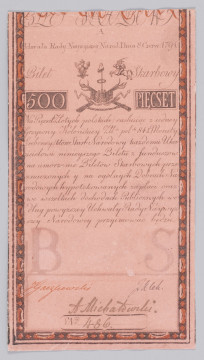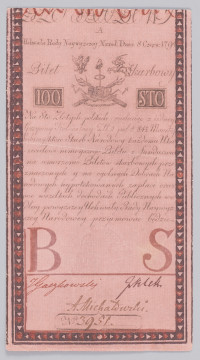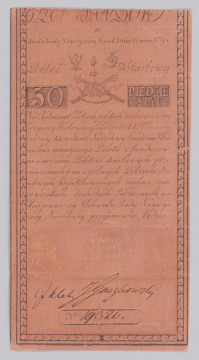
Treasury ticket - 500 Polish zlotys
1794
National Museum in Lublin
Part of the collection: Paper money of the Kościuszko Uprising and the Duchy of Warsaw
Tadeusz Kościuszko's search for the means needed to finance military operations during the Kościuszko Uprising prompted him to resort to a solution that has been theoretically considered in Poland since the 1870s. This measure was the introduction of paper money into circulation. On the orders of the uprising's leader, his executive body – the Supreme National Council – appointed the Directorate of Treasury Bills on 8 June 1794. The institution was in charge of preparing the issue of the new means of payment. Many technical issues had to be considered, including finding a supplier of appropriate paper, designing a layout, creating security features to make counterfeiting difficult, and so on. People were also needed to deal with the various issues. It is worth remembering that money, apart from its basic role, has almost always had symbolic and propagandistic functions. It was no different with the insurrectionary treasury tickets introduced into circulation on 16 August 1794. All the denominations issued at that time, i.e., 5, 10, 25, 50, 100, 500 and 1000 zlotys, had a common graphic design, in which revolutionary symbols, referring to the French Revolution, came to the fore. These were: the Phrygian cap, the armament of the sans-culottes, the towers of prison walls, the chains of absolutism, the thunders of the people and the wings of liberty. The national symbols of the Eagle and the Pogoń were treated in a somewhat marginal way.
The general graphic design of the tickets was the work of Jędrzej Kapostas, who, in 1790, published the memorandum Planta Laying Out a Project for a National Bank, to the Superior Deputation of the National Economy Project Given, in which he presented a project for the introduction of paper money. On the other hand, the supervision of the production stage of tickets and the design of revolutionary symbols was the work of the versatile engraver and inventor Karl Michael Gröll.
Individual revenue tickets differed mainly in the colour of the paper used for printing. The ten-zloty ones were printed on creamy-sand paper (like the presented ticket). However, there is a unique specimen in which the decorative frame, signatures and, above all, the reddish-pink paper used for printing are typical for the hundred-zloty tickets.
Leszek Poniewozik
Author / creator
Dimensions
cały obiekt: height: 98 mm, width: 183 mm
Object type
paper money
Technique
woodcut
Creation time / dating
Creation / finding place
Owner
The National Museum in Lublin
Identification number
Location / status

1794
National Museum in Lublin

1794
National Museum in Lublin

1794
National Museum in Lublin
DISCOVER this TOPIC
Castle Museum in Łańcut
DISCOVER this PATH
Educational path